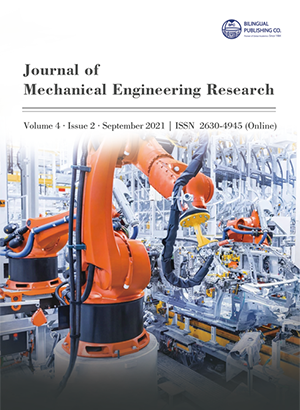Conception the Fluid Flow Behavior within Oil Reservoir Rock by Using Computed Tomography (CT) Scan
DOI:
https://doi.org/10.30564/jmer.v4i2.3194Abstract
The behavior of fluid flow has been studied during the different flow media over the past decades. In addition, the behavior of the flow of fluid through porous media has garnered much research interest. This paper sheds light on fissured rocks of oil reservoir media (as one of the porous media domain), and the effect of these fissured on fluid flow. In this article, the Finite Volume Method (FVM) has been used to visualize the behavior of single-phase fluid flow in an actual core according to the dualporosity dual permeability model. The study was conducted in two parts, the first was the image processing for one of the real oil reservoir fractured rock images, where the image was processed and simulated by ANSYSCFX software, and the results showed a complete visualizing of the fluid behavior during this domain. As for the other side, a simulation of a real reservoir rock belonging to the Al-Nour field in Iraq / Misan was made. The X-ray Computed Tomography (CT) scan has been used to convert the real fractured core to a dynamic domain. ANSYS-CFX program has been used and the results illustrated the pressure counter, the velocity counter, the velocity streamline, and the velocity vectors for the studied model in three dimensions. A comparison was made between the productivity index for fractured and non-fractured rock and the results explained that the presence of fracture can improve the productivity index to about 5.74%.
Keywords:
Computed Tomography (CT) scan; Al-Nour field; Fluid flowReferences
[1] Tsang, Y.W.: The effect of tortuosity on fluid flow through a single fracture. Water Resour. Res. 20, 1209-1215 (1984).
[2] Poon, C.Y., Sayles, R.S., Jones, T.A.: Surface measurement and fractal characterization of naturally fractured rocks. J. Phys. D. Appl. Phys. 25, 1269- 1275 (1992).
[3] Al-Yaarubi, A.H., Pain, C.C., Grattoni, C.A., Zimmerman, R.W.: Navier-Stokes simulations of fluid flow through a rock fracture. In: Faybishenko, B., Gale, J. (eds.) Dynamics of fluids and transport in fractured rocks, vol. 162 of AGU Monograph, pp. 55-64. American Geophysical Union, Washington, DC (2005).
[4] Randolph, L., Johnson, B.: Influence of faults of moderate displacement on groundwater flow in the Hickory Sandstone aquifer in central Texas. Abstracts - Geological Society of America 21, 242 (1989).
[5] Mozley, P.S., Goodwin, K.B.: Patterns of cementation along a Cenozoic normal fault: a record of paleo flow orientations. Geology 23, 539 - 542 (1995).
[6] Barenblatt G., Zheltov I., and Kochina I., ‘’Basic concepts in the theory of seepage of homogeneous liquids in fissured rocks [strata]’’, Journal of applied mathematics and mechanics, Vol. 24, No. 5, pp 1286- 1303, 1960.
[7] Odeh A. S., ‘’Unsteady state behavior of naturally fractured reseroir’’, Society of Petroleum Engineers Journal, Vol. 5, No. 1, pp 60-66, March, 1965.
[8] Kazemi H., ‘’Pressure Transient Analysis of Naturally Fractured Reservoirs with Uniform Fracture Distribution’’, Society of Petroleum Engineers Journal, Vol. 9, No. 04, pp 451-462, 1969.
[9] Pickett G. R., and Reynolds E. B., ‘’Evaluation of fractured reservoir’’, Society of Petroleum Engineers Journal, Vol. 9, No. 1, pp 28-38, March 1969.
[10] Abbasi M., Madani M., Shari M., and Kazemi A., “Fluid flow in fractured reservoirs: Exact analytical solution for transient dual porosity model with variable rock matrix block size”, Journal of Petoleum Science and Engineering, Vol. 164, pp 571-583, 2018.
[11] Al-Husseini A. J., Abood F. A., Alshara A. K., Hydrodynamics Behaviour of Single and Multi Fracture with Different Orientations in Petroleum Reservoir, Basrah Journal for Engineering Sciences, Vol.19, No.1, pp.12-16, (2019).
[12] Majeed A. J., Alshara A. K., Al-Mukhtar A. M., Abood F. A.: Fracturing Parameters in Petroleum Reservoirs and Simulation. Advances in Material Sciences and Engineering. Pp. 491-8, (2020).
[13] Luthi S. M. and Souhaitet P.: Fracture apertures from electrical borehole scans, Geophysic, Vol. 55, No. 7. pp 821-833, July, (1990).
[14] Hirono, T., Takahashi, M., Nakashima, S.: In situ visualization of fluid flow image within deformed rock by X-ray CT. Eng. Geol. 70, 37-46 (2003).
[15] Karpyn, Z.T., Grader, A.S., Halleck, P.M.: Visualization of fluid occupancy in a rough fracture using micro-tomography. J. Colloid Interface Sci. 307, 181- 187 (2007).
[16] Berg, R. R., ‘’Method for determining permeability from reservoir rock properties’’. Transactions Gulf Coast Association of Geological Societies, Vol. 20, pp 303-317, (1970).
[17] Guo B., Tao Y., Bandilla K., and Celia M., “Vertically Integrated Dual-porosity and Dual-permeability Models for CO2 Sequestration in Fractured Geological Formation”, Energy Procedia, Vol. 114, pp 3343- 3352, Nov., (2017).
[18] Weirong L., Dong Z., and Lei G., “Integrating Embedded Discrete Ffracture and Dual Porosity Method to Simulate Fluid Flow in Shale Oil Reservoir”, Energies, Vol. 10, No. 10, (2017).
[19] Hamdan M. H., ‘’ Single-Phase through Porous Channels A Review of Flow Models and Channel Entry Conditions’’. Applied Mathematics and Computation Vol. 62, No. 3, pp 203-222, May, 1994.
[20] Rudraiah N., Chandrasekhara B. C., Veerabhadraiah R., and Nagaraj S. T., ‘’Some Flow Problems in Porous Media’’, PGSAM-2, Bangalore University, India, 1979.
Downloads
Issue
Article Type
License
Copyright © 2021 Amani J. Majeed, Falah A. Abood, Ahmed K. Alshara

This is an open access article under the Creative Commons Attribution-NonCommercial 4.0 International (CC BY-NC 4.0) License.




 Amani J. Majeed
Amani J. Majeed

